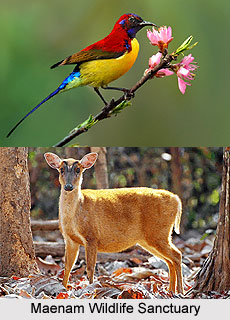 Maenam Wildlife Sanctuary is situated just above the Tendong Hill in the Northern Corner of the South Sikkim. The sanctuary houses a variety of animals and birds and is also rich in flora. It is 65 Kms from Gangtok, the capital town of Sikkim. Covered by thick forests the sanctuary is spread over an area of 36.43 sq kms. It serves as a delight for the wildlife lovers. The word `Maenam` means a `treasure house of medicines` and the sanctuary is has many plants of medicinal value.
Maenam Wildlife Sanctuary is situated just above the Tendong Hill in the Northern Corner of the South Sikkim. The sanctuary houses a variety of animals and birds and is also rich in flora. It is 65 Kms from Gangtok, the capital town of Sikkim. Covered by thick forests the sanctuary is spread over an area of 36.43 sq kms. It serves as a delight for the wildlife lovers. The word `Maenam` means a `treasure house of medicines` and the sanctuary is has many plants of medicinal value.
Maenam Wildlife Sanctuary is located at an altitude that ranges between 2300 meters to 3263 meters. The streams originating from the eastern side of the sanctuary unites with the Teesta River. Other streams that originate from the western flank gradually flows into the Rangeet River. One can get an imposing view of the Teesta River that flows far below.
Flora and Fauna of Maenam Wildlife Sanctuary
The thick forests of Maenam serve as an abode to many animals and plants. Some of the animals that can be seen here are Red Panda, Goral, Serow, Barking Deer, Marbled Cat, Leopard-Cat, Civet Cats, Blood Pheasant, Common Hill Partridge, Magpies, Black Eagle, Blue necked Pitta, Woodcock, Crested Serpent Eagle, Crimson Horned Pheasant, Green Pigeon, Speckled Wood Pigeon, Spotted Dove, Rufous Turtle Dove, Common Hawk Cuckoo, Warbler, Tree Sparrow, Common Rose Finch, Redheaded Bullfinch, Goldheaded Black Finch, and Sunbirds and many others.
Apart from its rich fauna, Maenam is also known for being a great trekking destination. A remarkable trek to Maenam Peak and further to Bhaledunga originates from Ravalngla, the nearest town located at a distance of 12 kms. The trek passes through the impressive alpine forests giving a striking view of the magnificent Kanchenjunga Peak. This trekking expedition takes around 4 hours. There is another trek route of Maenam to Borong village. The best season for trekking in this region starts from March and continues to the end of May. On the apex of this sanctuary
On the apex of Maenam Wildlife Sanctuary one can see a historical Buddhist Monastery Maenam Gumpha. The monastery was established by the Queen of Sikkim in 1969. Apart from this there is also is a temple of Lord Shiva. It is deeply revered and worshipped by the local villagers. Tourists come to the sanctuary while enjoying the adventure of trekking. It is a sacred place for the villagers.
The best time to visit Maenam Wildlife Sanctuary is during the months of March to May and September to November. The nearest airport is located at Bagdogra and the nearest Railway Station is located at New Jalpaiguri. One can also reach the sanctuary by taking regular jeeps or by hiring taxis. The sanctuary can also be reached from Ravangla, which is only at a distance of 26 kilometres.











